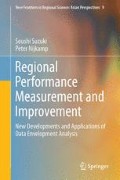Abstract
The aim of this chapter is to provide a very concise overview of Data Envelopment Analysis (DEA) and its subsequent improvements. DEA proposed by Charnes et al. (Eur J Oper Res, 2:429–444, 1978) and based on the seminal article by Farrell (J Roy Stat Soc 120:253–290, 1957) aims to develop a comparative measure for production efficiency. We present first a brief history of the development of DEA. Next, we make a comparison of DEA and stochastic frontier analysis (SFA). DEA is a nonparametric and deterministic approach, whereas SFA is a parametric and stochastic approach. We also focus on the history of the development of the efficiency-improvement projection model in DEA. The existence of many possible efficiency-improvement solutions has in recent years prompted a rich literature on the methodological integration of multiple objective quadratic programming (MOQP) and DEA models. The first contribution was made by Golany (J Oper Res Soc 39:725–734, 1988), and we introduce here a concise overview of the history of the development of efficiency-improvement projection models in DEA. Based on these backgrounds, we present advantages and features of our DFM (distance friction minimization) model.
Access this chapter
Tax calculation will be finalised at checkout
Purchases are for personal use only
References
Aigner, D., Lovell, C. A. K., & Schmidt, P. (1977). Formulation and estimation of stochastic frontier production function models. Journal of Econometrics, 6, 21–37.
Anderson, P., & Petersen, N. (1993). A procedure for ranking efficient units in data envelopment analysis. Management Science, 39, 1261–1264.
Angulo-Meza, L., & Lins, M. P. E. (2002). Review of method for increasing discrimination in Data Envelopment Analysis. Annals of Operations Research, 116, 225–242.
Banker, R. D., Charnes, A., & Cooper, W. W. (1984). Some models for estimating technical and scale inefficiencies in Data Envelopment Analysis. Management Science, 30, 1078–1092.
Belton, V. (1992). An integrating data envelopment analysis with multiple criteria decision analysis in A. In L. D. Goicoechea & S. Zionts (Eds.), Multiple criteria decision making (pp. 71–79). Berlin: Springer-Verlag.
Belton, V., & Vickers, S. P. (1993). Demystifying DEA – A visual interactive approach based on multiple criteria analysis. Journal of the Operational Research Society, 44, 883–896.
Bogetoft, P., & Otto, L. (2011). Benchmarking with DEA, SFA, and R (International series in operations research & management science, Vol. 157). New York: Springer Science + Business Media.
Charnes, A., Cooper, W. W., & Rhodes, E. (1978). Measuring the efficiency of decision making units. European Journal of Operational Research, 2, 429–444.
Cook, W. D., & Seiford, L. M. (2009). Data envelopment analysis (DEA) – Thirty years on. European Journal of Operational Research, 192, 1–17.
Cooper, W. W., Seiford, L. M., & Tone, K. (2006). Introduction to data envelopment analysis and its uses. Boston: Springer Science + Business Media Inc.
Doyle, R. H., & Green, J. R. (1993). Data envelopment analysis and multiple criteria decision making. Omega, 6, 713–715.
Emrouznejad, A., and Thanassoulis, E. (1997) An extensive bibliography of data envelopment analysis volume III, Supplement 1 (Research Papers, No. 258)
Farrell, M. J. (1957). The measurement of productive efficiency. Journal of the Royal Statistical Society, 120, 253–290.
Golany, B. (1988). An interactive MOLP procedure for the extension of DEA to effectiveness analysis. Journal of the Operational Research Society, 39, 725–734.
Halme, M., Joro, T., Korhonen, P., Salo, S., & Wallenius, J. (1999). A value efficiency approach to incorporating preference information in data envelopment analysis. Management Science, 45(1), 103–115.
Hjalmarsson, L., Kumbhakar, S. C., & Heshmati, A. (1996). DEA, DFA and SFA: A comparison. Journal of Productivity Analysis, 7(2), 303–327.
Joro, T., Korhonen, P., & Wallenius, J. (1998). Structural comparison of data envelopment analysis and multiple objective linear programming. Management Science, 44(7), 962–970.
Korhonen, P., & Siljamäki, A. (2002). On the use of value efficiency analysis and some further developments. Journal of Productivity Analysis, 17(1–2), 49–64.
Korhonen, P., Stenfors, S., & Syrjänen, M. (2003). Multiple objective approach as an alternative to radial projection in DEA. Journal of Productivity Analysis, 20(20), 305–321.
Kornbluth, J. S. H. (1991). Analysing policy effectiveness using cone restricted data envelopment analysis. Journal of the Operational Research Society, 42, 1097–1104.
Lins, M. P. E., Angulo-Meza, L., & Moreira da Silva, A. C. (2004). A multi-objective approach to determine alternative targets in data envelopment analysis. Journal of Operational Research, 55, 1090–1101.
Meeusen, W., & Broeck, J. (1977). Efficiency estimation from Cobb-Douglas production functions with composed error. International Economic Review, 8, 435–444.
Seiford, L. (2005). A cyber-bibliography for data envelopment analysis (1978–2005). CD-ROM in introduction to data envelopment analysis and its uses. New York: Springer Science Buisness Media.
Seiford, L. M., & Zhu, J. (2003). Context-dependent data envelopment analysis – Measuring attractiveness and progress. Omega, 31, 397.
Thanassoulis, E., & Dyson, R. G. (1992). Estimating preferred target input-output levels using data envelopment analysis. European Journal of Operational Research, 56, 80–97.
Tone, K. (2001). A slacks-based measure of efficiency on data envelopment analysis. European Journal of Operational Research, 130, 498–509.
Tone, K. (2002). A slacks-based measure of super-efficiency in data envelopment analysis. European Journal of Operational Research, 143, 32–41.
Author information
Authors and Affiliations
Rights and permissions
Copyright information
© 2017 Springer Science+Business Media Singapore
About this chapter
Cite this chapter
Suzuki, S., Nijkamp, P. (2017). Overview of DEA and Its Improvements. In: Regional Performance Measurement and Improvement. New Frontiers in Regional Science: Asian Perspectives, vol 9. Springer, Singapore. https://doi.org/10.1007/978-981-10-0242-7_2
Download citation
DOI: https://doi.org/10.1007/978-981-10-0242-7_2
Published:
Publisher Name: Springer, Singapore
Print ISBN: 978-981-10-0241-0
Online ISBN: 978-981-10-0242-7
eBook Packages: Economics and FinanceEconomics and Finance (R0)

